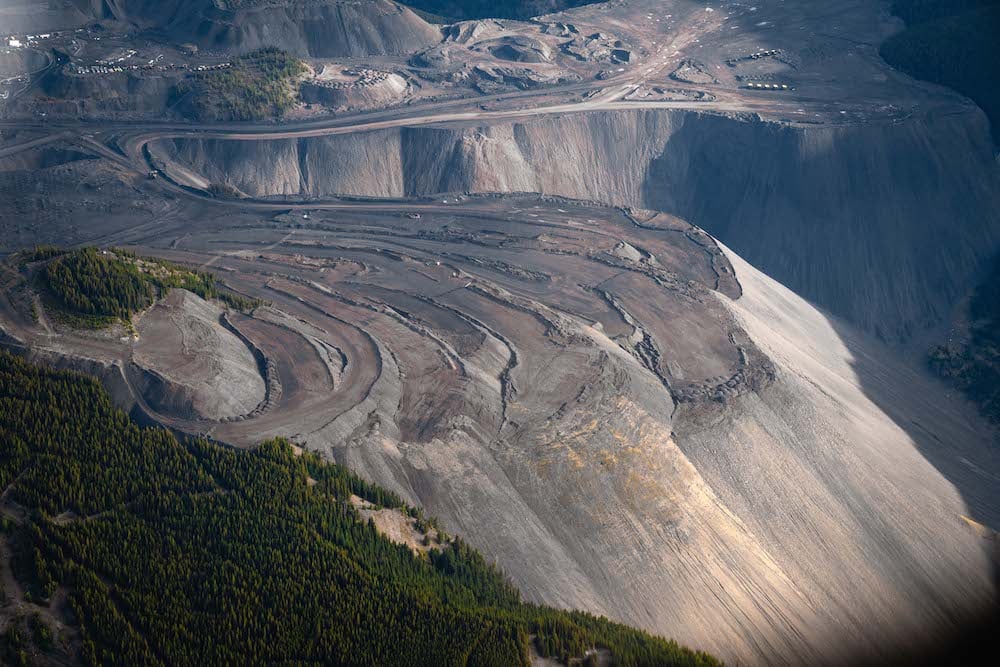In Alberta, the government of Jason Kenney has one definition for mountaintop removal, while most people have another.
You might think that excavating the top of a mountain until it’s reduced to a series of carved away “benches” that rise like giant steps to a last shred of a mountain’s peak is “mountaintop removal.”
If so, you disagree with the Alberta government.
Here’s someone else who disagrees with the Kenney definition. Australian coal miners.
While the Kenney government claims mountaintop removal can’t happen in Alberta’s water-sensitive eastern slopes, Benga Mining, an Australian firm owned by Aussie billionaire Gina Rinehart, says that’s the technique it intends to employ — and in a joint federal-provincial hearing no less.
Last week, the Kenney government told the Narwhal in a series of emails that open-pit mining can’t be called mountaintop removal if it only removes, say, 90 per cent of a mountaintop.
By Alberta’s definition, the top of the mountain has to be “completely” removed to qualify as mountaintop removal.
The Alberta Energy Regulator and Kenney spokesperson Kavi Bal both informed the Narwhal that open-pit mining can scrape off the sides of a mountain, devein coal seams and leave a ridge a pockmarked shadow of itself after removing tonnes of toxic debris, and that’s OK: because it’s open-pit mining, and not mountaintop removal.
Over the last two months, ranchers, towns, municipal districts and conservationists have made it plain they consider any proposal for open-pit coal mining in critical watersheds in the Rockies an unacceptable risk to their communities and water security.
In an attempt to defuse that protest, Alberta Energy Minister Sonya Savage vowed that she would ban “mountaintop removal” in the province and reinstate the Coal Policy that banned surface or open-pit mining in parts of the Rockies.
(Tellingly, she did not cancel six active exploration permits or 200,000 hectares of new leases granted while the government abolished the Coal Policy for nearly a year.)
But it now seems the province remains an unabashed supporter of open-pit mining in the Rockies, where half a dozen Australian companies hold coal leases on nearly 2,000 square kilometres of land in some of Alberta’s most important watersheds supplying water to half of the province’s citizens.
‘The techniques are the same’
Kavi Bal, the director of strategic planning in the premier’s office, told the Narwhal that “there are no historic or current mountaintop removal developments, and we are not aware of any future projects.”
But that’s not what Gary Houston, Benga Mining’s vice-president of external affairs, told a federal-provincial joint panel last fall.
Benga Mining, which has plans for multiple mines in the region, has proposed to remove four million tonnes of metallurgical coal off Grassy Mountain by turning the place into a giant open-pit mine.
Grassy Mountain, located in the historic Crowsnest Pass, has been mined before but never on this scale.
An underground mine pulled 14 million tonnes of coal out of the mountain over a 50-year period, and a surface open-pit mine removed 383,000 tonnes of coal over a four-year period (1956 to 1960) leaving a long scar just below the top of the mountain.
When asked by lawyer Gavin Fitch about the scale of what Benga was now proposing, Houston agreed that “it’s larger in area and volume of coal that would have been produced in the past.” The pit site covers 15 square kilometres of a 37-square-kilometre mine permit boundary “inaccessible by the public during construction and operation of the mine.”
“And then, Mr. Houston, is there any difference between open-pit mining and mountaintop removal mining?” asked Fitch, who represented the Livingstone Landowners Group, which is opposed to the mine.
“I think that they’re both the same thing,” replied Houston.
The mining executive later elaborated: “I’m saying that the techniques are the same, and there’s little distinction in terms of the process.”
Fitch continued his query: “And this mine will be located on a mountain, and you’re going to be removing the top of that mountain, correct?” “The coal — the coal deposits are up the mountain, yes, and — and so we’ll have to remove soil at the top of the mountain,” confirmed Houston.
The coal mining industry, which mostly digs up surface rock for economic reasons, generally avoids the term “mountaintop removal” because it viscerally describes what its mining practices do to mountains.
Mountaintop removal has also been called “strip-mining on steroids.”
The industry prefers to describe the excavation of mountains in chunks or strips as “open-pit mining” and “open-cut mining.”
But as Benga CEO Houston admitted before a joint federal-provincial panel, the destructive techniques “are the same thing.”
Except in Alberta, which says it has banned “mountaintop removal” while supporting “open-pit mining” in the Rockies.
As Derek Apel, a professor in the School of Mining and Petroleum Engineering at the University of Alberta, explained to the Narwhal, the Alberta government sees a chance to be slippery with definitions because coal seams in the Rockies run differently than they do in the Appalachian Mountains, where wholesale mountaintop removal has flattened the landscape, polluted waterways and sickened residents.
In the Rockies, Apel said the angle of mining tends to be at a slant, producing the effects of carving away the mounting in “benches” while possibly leaving a shard of the mountain top, like a blackened ghost, behind.
Photos of similar coal mining in the Elk Valley on the other side of the Rockies in B.C. show virtually nothing left of mountain tops. Teck Resources, whose B.C. operations have created a selenium crisis in Canadian and U.S. waterways, refers to its four open-pit coal mines as “four steelmaking coal operations” right next to a photo showing a mountain having its top removed.
In any case, the Kenney government tries to find refuge in such nitpicking about how to describe ecological ruin.
‘Grave environmental threat’
A U.S. scientist recently concluded that “If approved and made operational, the Grassy Mountain Coal Project will create a grave environmental threat from selenium pollution of high quality, high value aquatic habitats in a scenic Rocky Mountain landscape.”
Given the Kenney government’s sleight of hand for coal mining, the Livingstone Landowners Group has hired a group of independent scientists to undertake a science-based assessment “of the impacts on water quality and quantity in the Oldman River system that are expected to occur in the coming years if proposed coal mines in the headwaters area are approved and proceed.”
“The Oldman River watershed is one of the driest regions in Alberta and is facing increasing uncertainty in water balance because of increasing demand and reductions in water supply,” noted Brad Stelfox, a prominent land use ecologist and lead scientist on the study.
Will the Alberta government next tell us that homicides are not homicides unless the head has been completely removed?
*Story corrected March 11 at 2:39 p.m. to correct the size of the mine pit site. ![]()
Read more: Energy, Environment
















Tyee Commenting Guidelines
Comments that violate guidelines risk being deleted, and violations may result in a temporary or permanent user ban. Maintain the spirit of good conversation to stay in the discussion.
*Please note The Tyee is not a forum for spreading misinformation about COVID-19, denying its existence or minimizing its risk to public health.
Do:
Do not: